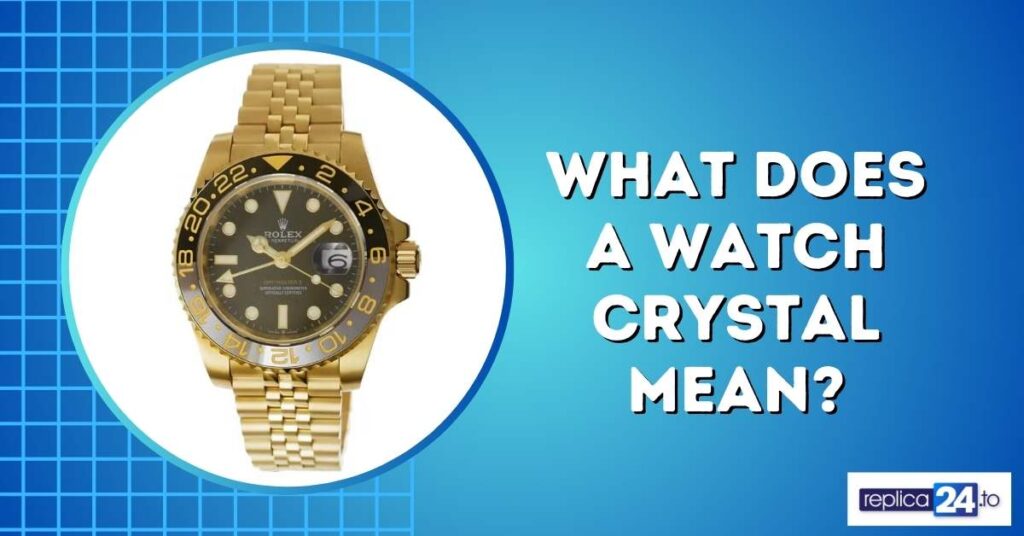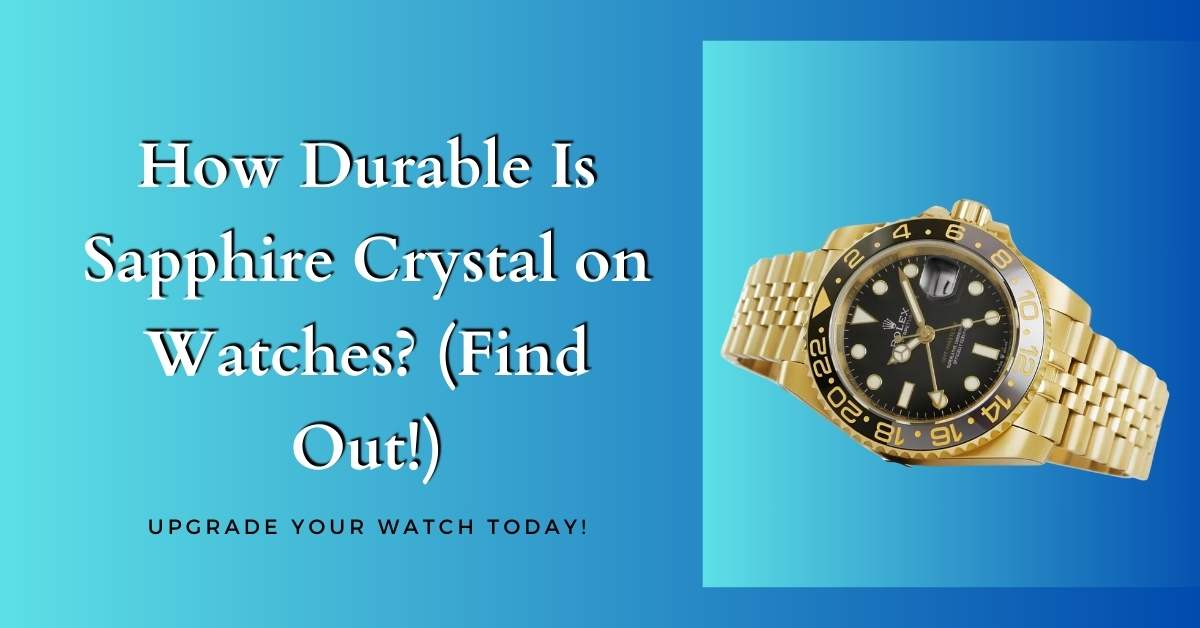Ever wondered why sapphire crystal is so often hailed as the superhero of watch crystals? You’re about to find out!
Sapphire crystal, known for its near-diamond hardness, is renowned for its incredible scratch resistance, making it a top choice for preserving your watch’s pristine appearance. But durability isn’t just about being scratch-proof; it’s about how well it can stand up to everyday wear and tear without losing its clarity or beauty.
In this article, we’re diving into the world of this highly praised watch component to uncover what makes it so special.
So keep reading if you’re pondering over whether a sapphire crystal watch is worth the investment or just curious about what sets it apart!
What Does a Watch Crystal Mean?

The term ‘watch crystal’ doesn’t refer to a crystal in the literal sense, but rather to the clear cover that protects the dial of the watch. This crucial component is responsible for safeguarding the watch’s face from external elements such as dust, water, and physical impacts.
Moreover, it plays a significant role in the watch’s readability and overall aesthetics. Depending on the material, the crystal can significantly enhance the visibility and durability of the watch.
There are several types of materials used for watch crystals, each with its own set of properties. The most common are sapphire, mineral, and acrylic.
Sapphire crystal, made from synthetic sapphire, gets love and appreciation for its exceptional scratch resistance and clarity. On the other hand mineral crystal, a type of treated glass, offers a balance between affordability and scratch resistance. And acrylic crystal, essentially a type of plastic, is the most affordable and offers good impact resistance but is more prone to scratches.
In conclusion, the watch crystal is more than just a transparent face; it’s an integral part of the watch’s design and functionality. Its choice influences not only the watch’s durability and readability but also its price and maintenance requirements.
How Durable Is a Sapphire Crystal?
In the world of luxury watches, sapphire crystal is often the material of choice for its exceptional durability and clarity. But what exactly makes sapphire crystal so durable, and how does it stand up against the rigors of daily use?
To understand this, we need to delve into the properties that make sapphire crystal a preferred choice in high-end timepieces.
Sapphire crystal is made from synthetic sapphire, a material that is second only to diamond in terms of hardness. This high level of hardness is what gives the sapphire crystal its renowned scratch resistance. Unlike softer materials that can easily accumulate scratches and scuffs from everyday activities, sapphire crystal maintains its pristine, clear appearance over time. This resistance to scratching ensures that the watch face remains unobstructed and easy to read, a crucial aspect of any timepiece.
However, it’s important to note that while the sapphire crystal is highly scratch-resistant, it is not completely scratch-proof. Under extreme conditions or when exposed to materials that rival its hardness, such as diamond, it can still face scratching.
Additionally, sapphire crystal’s hardness makes it more brittle compared to softer materials like acrylic or mineral glass. This means that while it resists scratches, it can be more prone to shattering if subjected to a severe impact or shock.
In terms of longevity, sapphire crystal fares excellently. Its resistance to scratches means that it can maintain its clarity and luster for many years, often outlasting the watch itself. This durability makes it an excellent investment for those who value longevity and quality in their timepieces.
Furthermore, sapphire crystal is resistant to thermal shocks and chemical corrosion, adding to its robustness in various environments.
Another aspect of sapphire crystal’s durability is its finish. Manufacturers often treat many sapphire crystals with anti-reflective coatings to enhance visibility and reduce glare. While these coatings can wear off over time, the underlying sapphire remains durable and clear.
In summary, sapphire crystal’s durability lies in its exceptional scratch resistance and long-lasting clarity. While it may be more susceptible to shattering upon severe impact, its overall resilience makes it a top choice for those seeking a blend of luxury, practicality, and longevity in their watches.
What Is the Disadvantage of Sapphire Crystal?
Although people love the Sapphire crystal for its durability and clarity, it is not without its drawbacks. One of the primary disadvantages of sapphire crystal is its cost.
As it’s a high-end material, watches with sapphire crystals tend to be more expensive. This cost factor can make such watches less accessible for budget-conscious consumers, limiting their options in the realm of luxury timepieces.
Another significant drawback of sapphire crystal is its brittleness. Despite its high scratch resistance, sapphire crystals are more prone to shattering upon impact compared to other types of watch crystals like mineral or acrylic. This susceptibility to cracking or breaking under severe impact can be a concern for those who lead active lifestyles or work in environments where their watch may be subjected to rough treatment.
Additionally, sapphire crystal’s hardness can sometimes lead to a greater glare, which can affect the readability of the watch under certain lighting conditions. While many sapphire crystals are treated with anti-reflective coatings to mitigate this issue, these coatings can wear off over time, potentially reducing visibility.
What Are the Other Watch Crystal Alternatives?
In addition to sapphire crystal, there are other materials commonly used for watch crystals, each offering its own set of characteristics and benefits.
These alternatives provide different options for consumers based on their specific needs and budget considerations.
1. Mineral Crystal
Mineral crystal is a popular alternative, made from glass that’s been heat-treated or chemically treated to improve its scratch resistance. While not as hard as sapphire, mineral crystal is more resistant to shattering upon impact. It strikes a balance between durability and cost, making it a suitable choice for a wide range of watches, especially in the mid-priced segment.
2. Acrylic Crystal
Acrylic crystal, made from a transparent plastic material, is the most affordable option. It’s less prone to shattering and is lightweight, making it comfortable for daily wear. Acrylic is less scratch-resistant than sapphire or mineral crystal but you can easily polish it to remove minor scratches. Often vintage watches and budget-friendly models use this kind of crystal.
3. Hardlex Crystal
Hardlex crystal, a type of hardened mineral crystal developed by Seiko, offers enhanced scratch resistance compared to standard mineral glass. It provides a middle-ground solution, offering better durability than regular mineral crystal but at a lower price point than sapphire.
Some FAQs
1. What Makes Sapphire Crystal So Scratch-Resistant?
Answer: Sapphire crystal’s hardness, second only to diamond, makes it highly resistant to scratches and abrasions.
2. Is Sapphire Crystal Worth the Extra Cost?
Answer: Yes, for durability and clarity, especially in high-end watches, sapphire crystal is often worth the additional cost.
3. Can Sapphire Crystal Shatter or Break?
Answer: While highly scratch-resistant, sapphire crystal can shatter or crack under severe impact due to its rigidity.
Conclusion
To conclude, sapphire crystal stands out as a champion in durability for watch faces. Its remarkable scratch resistance ensures your watch stays pristine over time. While it’s not invincible against severe impacts, its longevity and clarity make it a top choice for those valuing both resilience and elegance in their timepieces.








